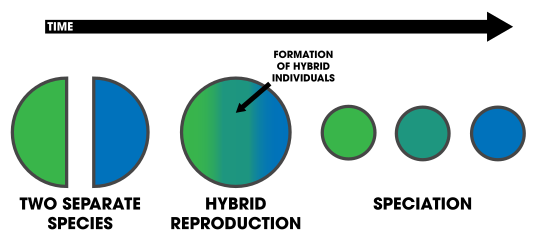انتواع تهجيني
| جزء من سلسلة مقالات عن |
| علم الأحياء التطوري |
|---|
 |
|
بوابة التطور تصنيف • مقالات متعلقة • كتب |
الانتواع التهجيني Hybrid speciation هو نوع من الانتواع الذي يؤدي فيه التهجين بين نوعين مختلفين تربط بينهما قرابة كبيرة إلى إنتاج نوع جديد، بحيث يكون منعزلًا تكاثريًا عن النوعين الأبويين. منذ الأربعينات كان يُعتقد أنه كان يصعب تحقيق انعزال تكاثري بين الكائنات الهجينة ووالديها، ولذلك اعتُبرت الأنواع الهجينة نادرة جدًا. ومع ازدياد اتاحة تحليل الدنا في التسعينات، تبين أنَّ الأنواع الهجينة هي ظاهرة شائعة نسبيا وخاصة في النباتات.[1][2] في تسمية النباتات، فإن الأنواع الهجينة تُدعى أيضاً nothospecies.[3] الأنواع الهجينة هي بطبيعتها polyphyletic.[4]
. . . . . . . . . . . . . . . . . . . . . . . . . . . . . . . . . . . . . . . . . . . . . . . . . . . . . . . . . . . . . . . . . . . . . . . . . . . . . . . . . . . . . . . . . . . . . . . . . . . . . . . . . . . . . . . . . . . . . . . . . . . . . . . . . . . . . . . . . . . . . . . . . . . . . . . . . . . . . . . . . . . . . . . .
البيئة
A hybrid may occasionally be better fitted to the local environment than the parental lineage, and as such, natural selection may favor these individuals. If reproductive isolation is subsequently achieved, a separate species may arise. Reproductive isolation may be genetic, ecological,[5] behavioral, spatial, or a combination of these.
الانتواع التهجيني في الحيوانات
Homoploid hybrid speciation
انظر أيضاً
- Clymene dolphin
- Eastern coyote
- Coywolf
- Genetic pollution
- Hybrid name
- New Mexico whiptail
- Secondary contact
- Ring species
مراجع
- ^ Arnold, M.L. (1996). Natural Hybridization and Evolution. New York: Oxford University Press. p. 232. ISBN 978-0-19-509975-1.
- ^ Wendel, J F. & Doyle, J.J. (1998): DNA Sequencing. In Molecular Systematics of Plants II. Editors: D.E. Soltis, P.S. Soltis, J.J. Doyle. Kluwer, Boston, pp. 265–296.
- ^ McNeill, J.; Barrie, F.R.; Buck, W.R.; Demoulin, V.; Greuter, W.; Hawksworth, D.L.; Herendeen, P.S.; Knapp, S.; Marhold, K.; Prado, J.; Prud'homme Van Reine, W.F.; Smith, G.F.; Wiersema, J.H.; Turland, N.J. (2012). International Code of Nomenclature for algae, fungi, and plants (Melbourne Code) adopted by the Eighteenth International Botanical Congress Melbourne, Australia, July 2011. Vol. Regnum Vegetabile 154. A.R.G. Gantner Verlag KG. ISBN 978-3-87429-425-6. Article H.1
- ^ Hörandl, E.; Stuessy, T.F. (2010). "Paraphyletic groups as natural units of biological classification". Taxon. 59 (6): 1641–1653. doi:10.1002/tax.596001.
- ^ Marques, I.; Draper, D.; López-Herranz, M. L.; Garnatje, T.; Segarra-Moragues, J. G.; Catalán, P. (2016-11-03). "Past climate changes facilitated homoploid speciation in three mountain spiny fescues (Festuca, Poaceae)". Scientific Reports (in الإنجليزية). 6 (1): 36283. Bibcode:2016NatSR...636283M. doi:10.1038/srep36283. ISSN 2045-2322. PMC 5093761. PMID 27808118.
